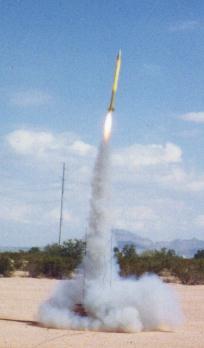AAA Model Aviation Fuels Quadra G
AAA Model Aviation Fuels - Quadra G {Kit}
Contributed by Moira Jean Whitlock
| Diameter: | 3.10 inches |
| Manufacturer: | AAA Model Aviation Fuels |

(Contributed - by Moira Jean Whitlock)
 Brief:
Brief:
This is a single staged rocket that can be flown on either 2 or 4 29mm motors.
Construction:
The main body tube runs from the top of the motor tubes to the nose cone. There
is one body tube and four motor tubes that extend outward from the main body.
This rocket has a very clever fin alignment system. The 4 fins are made from two wing-like pieces of wood that interlock in the middle to form 4 perpendicular fins. Then the 4 motor tubes fit over this structure and are epoxied in place. I used 12 minute epoxy.
The instructions are pretty clear and simple. All the parts were there and were well made. The fins weren't even rough. But they did need a little beveling. I did this with a finishing sander. The wood appears to be 1/8 inch thick birch.
About the hardest thing to align is the motor tubes inside the main frame. They extend out 20 plus inches from the main body tube. It seemed easy to get them cock-eyed, so I sight aligned them while the epoxy holding them dried. A centering ring further reinforces their connection and placement inside the body tube. Two beveled launch lugs are supplied that take as big as my 3/8 inch rod.
The recovery system is another clever design. It is a coupler and bulkhead with holes in it like a baffle. A screweye anchors the round nylon shock cord. The chute was supplied, and is a thin nylon, bright yellow 24 incher.
Finishing:
I spray painted it gold and decorated it with metallic prismatic paper. There
is a Quadra G decal lettering, so I applied the letters. I only got the word,
"Quad" and not "Quadra" but I figured that it was okay. I
was going to call the flight "Clusterophobia" instead anyway. The
result is striking and unique. The four extended motor tubes make it look
unusual.
Construction Rating: 4 out of 5
 Flight:
Flight:
The company suggests using motors with low average thrust and long delays. So,
my first flight was with 2 G35-7W's and 2 G40-7W's. The like motors were
diagonally arranged. The flight was straight and gorgeous. There seemed to be
deployment just slightly before apogee, so I surmised that the delay was too
short. The nylon shock cord was stressed after this as well, so I replaced it
with 10 feet of 1000 lb. Kevlar® cording. Then I flew it twice on 4 G40-10W's.
Everyone LOVED this. Straight, high, and loud. It even made a club video
memory. I did have to walk a bit, but I think I caught a thermal.
Recovery:
Use 10 second delays with 4 motors. 7 is okay with 2, probably. I did notice
that with the baffle, my usual method of spent motor removal with a rod is
impossible. Pliers were needed. The rocket is a little scratched, but able to
fly more. The chute is unburnt as well.
Flight Rating: 5 out of 5
Summary:
Clever design, not too bad a price. I remember paying around $45 for it. Great
fun for us cluster-people. Nice and loud and fiery. I highly recommend it.
Catching it on film with a long flame trail was really wonderful as well.
Overall Rating: 4 out of 5
Sponsored Ads
 |
 |











